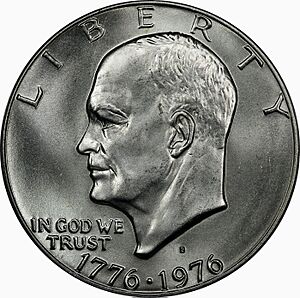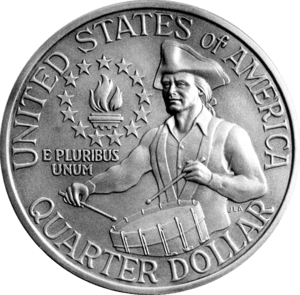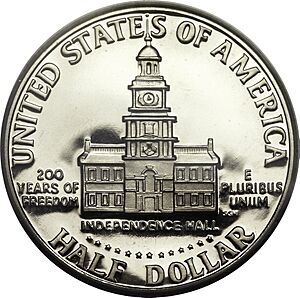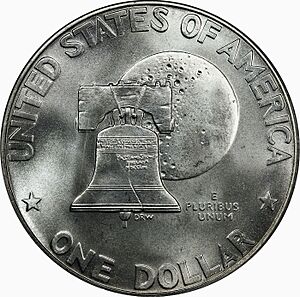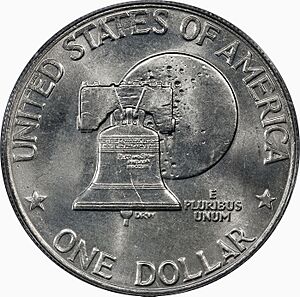United States Bicentennial coinage facts for kids
The United States Bicentennial coinage is a special set of coins made by the United States Mint in 1975 and 1976. These coins were created to celebrate the 200th birthday (Bicentennial) of the United States. The set includes a quarter, a half dollar, and a dollar.
Even though they were made in 1975 and 1976, all these coins show the special double date "1776–1976" on their front (obverse) side. This means no regular coins dated 1975 were made for these three types.
In the past, the Mint had problems with special commemorative coins. Because of this, they didn't want to make new ones after the 1950s. But starting in 1971, members of Congress wanted to create coins to honor the Bicentennial in 1976.
At first, the Mint's director, Mary Brooks, was against these ideas. However, she later changed her mind and supported them. Congress then passed a law that required the back (reverse) designs of the quarter, half dollar, and dollar to be temporarily changed.
A nationwide contest was held to find new designs. The winning designs featured a Colonial drummer for the quarter, Independence Hall for the half dollar, and the Liberty Bell over the Moon for the dollar. Many of these coins were made, so they are still very common today. The coins made for everyday use were copper-nickel. Congress also ordered 45 million special coins made with some silver for collectors. The Mint sold more than half of these silver coins before melting the rest in 1986.
Contents
Why Were Bicentennial Coins Created?
Early Commemorative Coins and Problems
The United States Mint had been making special Commemorative coins since 1892. These coins celebrated different events and anniversaries. Usually, groups would ask Congress to approve a coin. Then, these groups would buy the coins and sell them to the public for a higher price.
The last of these early special coins were half dollars honoring Booker T. Washington and George Washington Carver. They were made for several years and stopped in 1954. These coins were first sold for $3.50. But their price was lowered many times. Many couldn't be sold for a profit and ended up being used as regular money. The person in charge of selling these coins, S.J. Phillips, managed the sales poorly and lost $140,000. This bad publicity made the Treasury Department, which runs the Mint, oppose any new special coin ideas. Because of this, Congress didn't approve any more until the 1970s.
Planning for the Bicentennial Celebration
In 1966, Congress created the American Revolutionary Bicentennial Commission (ARBC). This group was set up to plan and organize events for the 1976 Bicentennial. In February 1970, the ARBC formed a committee to advise on coins and medals.
This committee first suggested making a special half dollar for the Bicentennial in July 1970. By December 1970, they wanted special designs for all U.S. coins for the Bicentennial. The ARBC agreed with this idea the next month. However, the Treasury Department was still against changing coins, sticking to its old rule about special coins. Several ideas for Bicentennial coins were introduced in Congress in 1971 and 1972, but none of them passed.
Mint Director Mary Brooks attended the committee meetings. She supported the idea of putting a "1776–1976" double date on regular coins. She knew it would be hard to fit two dates on the front of the coins. But in a newspaper interview, she called the idea of changing all six circulating coins (from the cent to the dollar) "a disaster." She thought if any Bicentennial coin was made, it should be a non-circulating one, like a half cent or a gold coin. Brooks believed this would not stop the Mint from making regular coins. However, by the end of 1972, she changed her mind. She convinced Treasury Secretary George P. Shultz to support a Bicentennial coin bill.
How the Bicentennial Coins Were Approved
Congressional Bills and Debates
In January 1973, Representative Richard C. White from Texas introduced a bill for special dollars and half dollars. Senator Mark Hatfield from Oregon also proposed a bill for a $25 gold piece. On March 2, 1973, the Treasury Department announced it supported Bicentennial coin laws. They sent their own bill to Congress three days later. This bill suggested changing only the back designs of the circulating dollars and half dollars.
Hearings were held in the House of Representatives on May 2, 1973. Mint Director Brooks spoke, supporting the limited design changes in the bill. She was against bigger coin redesigns. She also asked for permission to make U.S. coins at the West Point Bullion Depository. This place had extra room for old coin presses. Brooks didn't like Hatfield's gold coin idea. She said the coin would have to be less than 66.7% pure gold to prevent people from hoarding it.
After these hearings, more bills were introduced. Another hearing was held in the Senate on June 6. Brooks spoke again. People had complained that only the two least popular coins (dollar and half dollar) were being changed. Brooks then said she supported a Bicentennial quarter as well.
On June 13, a bill (S. 1141) was approved by the Senate Banking Committee. This bill allowed for a circulating Bicentennial quarter, half dollar, and dollar. It also gave permission to strike coins at West Point. And it allowed for 40% silver clad versions of the new coins for collectors. The bill passed the Senate on July 13. However, amendments were added to the bill. These amendments allowed U.S. citizens to own gold and to create Hatfield's proposed gold coin. A similar bill passed the House of Representatives on September 12. This House bill did not include anything about gold or silver versions of the new coins.
Final Law and President Nixon's Approval
Members from both houses of Congress met on September 19. The meeting was described as "fairly hot and heavy." The final bill did not include any gold provisions. But it did approve changes to the back designs of the quarter, half dollar, and dollar for the Bicentennial. The front designs of the three coins would not change. However, they would all show the double date "1776–1976."
The law stated that all coins made after July 4, 1975, and before January 1, 1977, would have the Bicentennial dates and designs. Congress told the Mint to make 45 million silver clad coins (which meant 15 million sets of three coins). The Mint also got permission to strike coins at West Point. Regular quarters, half dollars, and dollars for circulation would continue to be made of copper-nickel. The changed bill passed both houses of Congress on October 4, 1973. President Richard Nixon signed the bill into law on October 18.
Hatfield's idea for a gold coin, and similar bills, were brought up again in 1975 but did not pass. Bills for a Bicentennial two-cent piece and a coin honoring Abigail Adams and Susan B. Anthony also failed. The extra coin production at West Point was very important. It helped solve a shortage of cents in 1974. It also gave the Mint more flexibility as it got ready to make the Bicentennial coins.
Choosing the Designs
The Design Competition
On October 23, 1973, the Treasury Department announced a competition for the three new back designs. Any U.S. citizen could submit one drawing or a photo of a plaster model. The model had to be 10 inches (25 cm) across. The law required that all submissions include the words "UNITED STATES OF AMERICA," "E PLURIBUS UNUM," and the coin's value (e.g., "QUARTER DOLLAR"). Treasury Secretary Shultz, with advice from a group of judges, would choose the winning design for each coin.
Mint Director Brooks asked the National Sculpture Society to choose the five judges for the competition. The judges included the society's president, Robert Weinman, sculptor Adlai S. Hardin, former Mint Chief Engraver Gilroy Roberts, Julius Lauth, and Elvira Clain-Stefanelli from the Smithsonian Institution.
The deadline for entries was first December 14, 1973. But it was moved to January 9, 1974, because of the energy crisis and Christmas mail delays. Brooks traveled over 7,000 miles (11,000 km) to tell people about the competition. By the deadline, the Mint had received 15,000 questions and 884 entries. People on the judging panel and government sculptors could not enter. The prize for each of the three winners was $5,000. The judging was supposed to happen at West Point, but because of the delay, it took place at the Philadelphia Mint.
The judges picked twelve semifinalist designs. Each sculptor who submitted one of these designs received $750. The artists were asked to put their work on plaster models if they hadn't already. They were also offered help to make the models.
Announcing the Winners
The twelve semifinalist designs were shown to the public in early 1974. Two designs showed sailing ships. Two showed Independence Hall in Philadelphia, where the Declaration of Independence was signed. And three designs showed the Moon or lunar spacecraft. Another design showed the Liberty Bell on top of an atomic symbol. According to coin expert Michael Marotta, people who collected coins complained about the designs.
From the twelve, the judges chose six finalists. These were reviewed by the National Bicentennial Coin Design Competition Committee. This committee included Brooks, Representative Wright Patman, Senator John Sparkman, Charles H. Atherton, and Eric P. Newman. After getting the committee's suggestions, Secretary Shultz chose the winners.
On March 6, 1974, Brooks announced the winners on the Today TV show.
- Quarter: Jack L. Ahr's design of a colonial drummer with a torch of victory, surrounded by thirteen stars (for the original states).
- Half Dollar: Seth Huntington's image of Independence Hall.
- Dollar: Dennis R. Williams' design of the Liberty Bell over the Moon.
Ahr owned an art company. Huntington was the main artist for a publishing company. Williams, at 21, was the youngest person to design a U.S. coin. He had created his design for a class project. The front designs of the coins would only change to include the double date.
Ahr was accused of copying his drummer design from a 1973 stamp. The stamp's designer, William A. Smith, made the accusation. Ahr denied it. Coin historian Walter Breen said that both designs likely came from Archibald Willard's 1876 painting Spirit of '76. Ahr, however, said his son was the model for the drummer. Brooks wrote to Smith, saying the quarter design was "sufficiently original." Weinman later said he didn't think the winning designs were "a great bargain."
On April 24, 1974, the three winning designers came to Washington, D.C. They toured the White House and met with congressional committees. Then they went to the Treasury Building. There, they received their $5,000 checks from the new Treasury Secretary, William E. Simon.
Mint Chief Engraver Frank Gasparro made small changes to all three back designs. He simplified the quarter design. He changed the drum to make it look more real. He also changed the lettering and the drummer's face. He made slight changes to Independence Hall on the half dollar. He changed the lettering on the dollar to help the metal flow better during stamping. He also asked the dollar designer to straighten the bottom edge of the Liberty Bell. Ahr later said he wished he had more time to finish his design. He wanted to make the drummer's face clearer. The Mint added the designers' initials to the designs. All three designers agreed that Gasparro's changes made their designs better.
Making the Bicentennial Coins
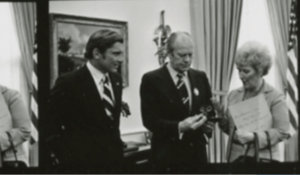
| Type II Eisenhower dollar (1976). | |
|---|---|
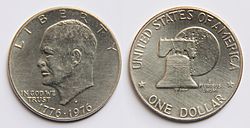 |
|
| 40% silver version. |
On August 12, 1974, the three designers visited the Philadelphia Mint. They ceremonially operated the presses to strike the very first coins with their designs. These first coins were shown under armed guard at a coin convention in Florida the next day. These special prototype coins were struck in silver proof and did not have a mint mark. Other silver proof coins have an "S" mint mark, meaning they were made at the San Francisco Assay Office. Coins made at Denver have a "D" mint mark. Coins without a mint mark were made at Philadelphia.
Sets of these first coins were given to President Gerald Ford, Counselor to the President Anne Armstrong, and Director John Warner. All other first strikes were melted down. Not even copies were kept for the National Numismatic Collection.
The Mint worried that if they had to make 1975 quarters, half dollars, and dollars, they wouldn't make enough before starting the Bicentennial coins. This could lead to coin shortages. Mint officials asked Congress to change the law. President Ford signed a bill on December 26, 1974. This bill allowed the Mint to keep making 1974-dated coins until they started making the Bicentennial coins. The new Bicentennial coins could not be released until after July 4, 1975.
Sales and Types of Coins
On November 15, 1974, the Mint started taking orders for the silver clad coins. A proof set cost $15, and an uncirculated set cost $9. The deadline for orders was January 31, 1975. At first, buyers could only order five sets per person. On January 19, 1975, Brooks announced that the silver proof set price was cut to $12. The order limit was also removed. Buyers who paid the higher price received refunds. Brooks said the price cut was due to better production methods. However, coin experts noted that the price cut came after many complaints that the price was too high.
The first Bicentennial coins for the public were dollars, made in February 1975. The first ones for collectors were made at San Francisco on April 23, 1975. The San Francisco Assay Office made all 45 million silver coins first. They produced 11 million uncirculated sets and 4 million proof sets. Then, they started making the base metal coins.
Once they started making the coins, the Mint found that the copper-nickel dollar was not striking clearly. This problem was not seen with the silver coins. The Mint changed the dies. The most noticeable change is that the new version, called Type II, has narrower, sharper letters on the back. All silver coins (made only at San Francisco) are Type I. All three mints made both Type I and Type II copper-nickel coins. All dollars in 1975 proof sets are Type I. All dollars in 1976 proof sets are Type II. Bicentennial coins for collectors were not delivered until after July 4, 1975. The base metal Bicentennial coins were included in 1975 proof sets and mint sets, along with 1975-dated cents, nickels, and dimes.
The new coins first entered circulation on July 7, 1975. The half dollar was released first in Minneapolis, the hometown of its designer, Seth Huntington. The quarter followed in September, and the dollar in October. Each release had special ceremonies. Many more coins were made than needed for circulation. A Mint spokesperson said, "The idea in striking them was to have enough available so as many Americans as possible would have an opportunity to have a coinage commemoration of the Bicentennial year. They're mementos."
End of Sales and Current Value
In 1977, the Mint went back to the old reverse designs for the quarter, half dollar, and dollar. Sales of the Bicentennial sets had dropped a lot by mid-1977. By 1979, the Mint hoped to eventually sell all the silver proof sets. But they knew it was unlikely to sell all the uncirculated silver sets.
On September 17, 1979, due to a sharp rise in silver prices, Mint Director Stella B. Hackel announced that the sets were no longer for sale. They were put back on sale in August 1980, at higher prices: $20 for proof sets and $15 for uncirculated sets. In September 1981, the Mint lowered the prices again because silver prices dropped. The sets were then $15 for proof and $12 for uncirculated. A limit of 100 sets per person was set for proof sales, with no limit on uncirculated sets. A large number of sets were melted by the government in 1982.
On December 31, 1986, the remaining Bicentennial uncirculated silver sets were removed from sale. At that time, it was announced that proof sets had already sold out. However, coin expert Michael Marotta stated in 2001 that when sales stopped, 400,000 proof sets and 200,000 uncirculated sets were still left.
Because so many Bicentennial coins were made, they are still inexpensive today. A set of three silver coins contains about 0.5381 troy ounces (16.74 g) of silver. In a 1996 study, T.V. Buttrey found that about 750 million of the circulating quarters, more than a third, were kept by people and not used as money. Coin dealer Marcel Sassola said in 1977 about the silver sets, "There were just too many sold, and I think it will take a long time before they have any real value. Maybe by the Tricentennial."
Coin Production Numbers
Here are the total numbers of Bicentennial coins made by each Mint location:
| Circulation coins | Philadelphia | Denver |
|---|---|---|
| Quarters | 809,784,016 | 860,118,839 |
| Half dollars | 234,308,000 | 287,565,248 |
| Dollars (Type I) | 4,019,000 | 21,048,710 |
| Dollars (Type II) | 113,318,000 | 82,179,164 |
| San Francisco (sets) | Copper nickel | Silver clad |
|---|---|---|
| In 1975 proof sets (six coins, cent through dollar) | 2,845,450 | 0 |
| In 1976 proof sets (six coins, as above) | 4,149,730 | 0 |
| Actual number of silver uncirculated sets issued | 0 | 4,908,319 |
| Actual number of silver proof sets issued | 0 | 3,998,621 |
Images for kids


